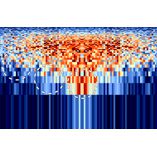2015/07/01
Time-resolved imaging of atoms and molecules is critical for understanding chemical reactions. To acquire such images, researchers typically bombard atoms or molecules with short laser pulses and then measure the emitted electron distribution. These pulses are often provided by near-infrared Ti:Sapphire lasers because they are more readily available, but the data are ambiguous to interpret. Now, researchers in the Attoscience and Ultrafast Optics group led by ICREA Professor at ICFO Jens Biegert, have overcome these problems and investigated atomic and molecular structure using a unique combination of a mid-infrared laser source with a 3D detector. This paper, published in the journal PRX, has also been highlighted in APS Physics this week.
The authors study ionization in the strong-field regime, in which the laser pulse distorts the electric field of the atom, allowing an electron to tunnel into the vacuum. The emitted electron accelerates within the strong electric field of the laser before recolliding with its parent ion and either recombining or scattering. Compared to shorter-wavelength pulses, mid-infrared pulses lead to unambiguous conditions in which electrons tunnel at much lower intensities. The electric fields of longer-wavelength lasers also accelerate the electrons for more time, which results in a quadratic increase in the electron energy. This provides the ability to probe nuclear rather than electronic structure at unprecedented resolutions.
To demonstrate the technique, the researchers shone a 3.1 micrometer laser into a cold, diffuse xenon gas to produce electrons and Xe+ and Xe2+ ions. They measured the arrival times and positions of the emitted electrons using a detector that recorded the charges’ momenta in three dimensions and over six orders of magnitude of energy.
Link to paper
Highlight in APS Physics
Research group led by Prof Jens Biegert

Strong-Field Physics with Mid-IR Fields in PRX with highlight in APS Physics
Imaging structure and response of atoms and molecules with powerful mid infrared electric fields in PRX

Image shows first measurement of double ionization of Xe to investigate correlation of tunneling electrons











